
Roy Fox Lichtenstein was an American pop artist. He rose to prominence in the 1960s through pieces which were inspired by popular advertising and the comic book style. Much of his work explores the relationship between fine art, advertising, and consumerism.
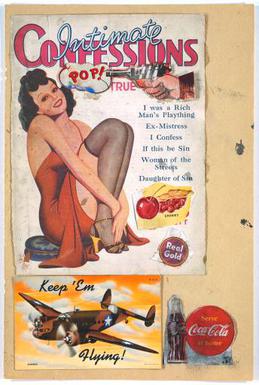
Pop art is an art movement that emerged in the United Kingdom and the United States during the mid- to late-1950s. The movement presented a challenge to traditions of fine art by including imagery from popular and mass culture, such as advertising, comic books and mundane mass-produced objects. One of its aims is to use images of popular culture in art, emphasizing the banal or kitschy elements of any culture, most often through the use of irony. It is also associated with the artists' use of mechanical means of reproduction or rendering techniques. In pop art, material is sometimes visually removed from its known context, isolated, or combined with unrelated material.

Whaam! is a 1963 diptych painting by the American artist Roy Lichtenstein. It is one of the best-known works of pop art, and among Lichtenstein's most important paintings. Whaam! was first exhibited at the Leo Castelli Gallery in New York City in 1963, and purchased by the Tate Gallery, London, in 1966. It has been on permanent display at Tate Modern since 2006.

Girl with Ball is a 1961 painting by Roy Lichtenstein. It is an oil on canvas Pop art work that is now in the collection of the Museum of Modern Art, after being owned for several decades by Philip Johnson. It is one of Lichtenstein's earliest Pop art works and is known for its source, which is a newspaper ad that ran for several decades and which was among Lichtenstein's earliest works sourced from pop culture.

Torpedo...Los! is a 1963 pop art oil on canvas painting by Roy Lichtenstein. When it was last sold in 1989, The New York Times described the work as "a comic-strip image of sea warfare". It formerly held the record for the highest auction price for a Lichtenstein work. Its 1989 sale helped finance the construction of the current home of the Museum of Contemporary Art, Chicago in 1991.

Look Mickey is a 1961 oil on canvas painting by Roy Lichtenstein. Widely regarded as the bridge between his abstract expressionism and pop art works, it is notable for its ironic humor and aesthetic value as well as being the first example of the artist's employment of Ben-Day dots, speech balloons and comic imagery as a source for a painting. The painting was bequeathed to the Washington, D.C., National Gallery of Art upon Lichtenstein's death.
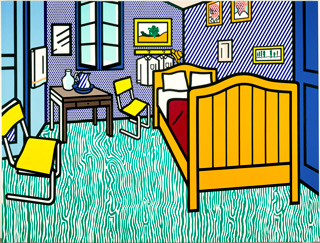
Bedroom at Arles is a 1992 oil and Magna on canvas painting by Roy Lichtenstein based on the Bedroom in Arles series of paintings by Vincent van Gogh. He painted it in July 1992. It is the only quotation of another painting that Lichtenstein did of an interior. It is located on the Fitzhugh Farm in Maryland in the Robert and Jane Meyerhoff Collection.
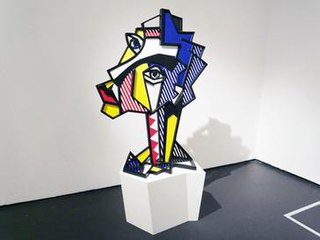
Expressionist Head by pop artist Roy Lichtenstein is the name associated with several 1980s works of art. It is widely associated with a set of six identical sculptures but is also associated with a series of paintings.

Big Painting No. 6 is a 1965 oil and Magna on canvas painting by Roy Lichtenstein. Measuring 235 cm × 330 cm, it is part of the Brushstrokes series of artworks that includes several paintings and sculptures whose subject is the actions made with a house-painter's brush. It set a record auction price for a painting by a living American artist when it sold for $75,000 in 1970. The painting is in the Kunstsammlung Nordrhein-Westfalen collection.
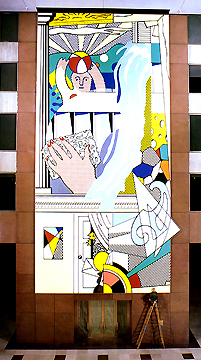
Mural with Blue Brushstroke is a 1986 mural painting by Roy Lichtenstein that is located in the atrium of the Equitable Tower in New York City. The mural was the subject of the book Roy Lichtenstein: Mural With Blue Brushstroke. The mural includes highlights of Lichtenstein's earlier works.
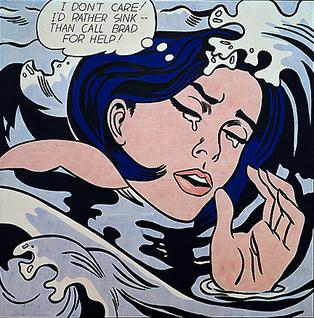
Drowning Girl is a 1963 American painting in oil and synthetic polymer paint on canvas by Roy Lichtenstein, based on original art by Tony Abruzzo. The painting is considered among Lichtenstein's most significant works, perhaps on a par with his acclaimed 1963 diptych Whaam!. One of the most representative paintings of the pop art movement, Drowning Girl was acquired by the Museum of Modern Art in 1971.
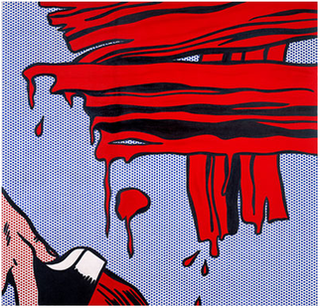
Brushstrokes series is the name for a series of paintings produced in 1965-1966 by Roy Lichtenstein. It also refers to derivative sculptural representations of these paintings that were first made in the 1980s. In the series, the theme is art as a subject, but rather than reproduce masterpieces as he had starting in 1962, Lichtenstein depicted the gestural expressions of the painting brushstroke itself. The works in this series are linked to those produced by artists who use the gestural painting style of abstract expressionism made famous by Jackson Pollock, but differ from them due to their mechanically produced appearance. The series is considered a satire or parody of gestural painting by both Lichtenstein and his critics. After 1966, Lichtenstein incorporated this series into later motifs and themes of his work.

Blam is a 1962 painting by Roy Lichtenstein falling within the pop art idiom. It is one of his military comic book derivatives and was one of the works presented at his first solo exhibition. The work is in the collection at the Yale University Art Gallery

Engagement Ring is a 1961 pop art painting by Roy Lichtenstein. The work is based on the Winnie Winkle series, but Lichtenstein changed both the graphical description and the narrative accompaniment that he presents in a speech balloon. As with most of his early romance comics works, this consisted of "a boy and a girl connected by romantic dialogue and action".

Golf Balls is a 1962 painting by Roy Lichtenstein. It is considered to fall within the art movement known as pop art. It depicts "a single sphere with patterned, variously directional semi-circular grooves." The work is commonly associated with black-and-white Piet Mondrian works. It is one of the works that was presented at Lichtenstein's first solo exhibition and one that was critical to his early association with pop art. The work is commonly critiqued for its tension involving a three-dimensional representation in two dimensions with much discussion revolving around the choice of a background nearly without any perspective.
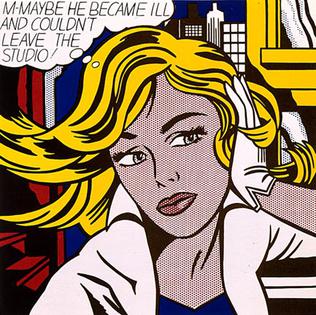
M-Maybe is a 1965 pop art painting by Roy Lichtenstein. It is one of his romance comics-based works.

In the Car is a 1963 pop art painting by Roy Lichtenstein. The smaller, older of the two versions of this painting formerly held the record for highest auction price for a Lichtenstein painting. The larger version has been in the collection of the Scottish National Gallery of Modern Art in Edinburgh since 1980.

Brushstrokes is a 1965 oil and Magna on canvas pop art painting by Roy Lichtenstein. It is the first element of the Brushstrokes series of artworks that includes several paintings and sculptures. As with all of his Brushstrokes works, it is in part a satirical response to the gestural painting of Abstract Expressionism.

Crying Girl is the name of two different works by Roy Lichtenstein: a 1963 offset lithograph on lightweight, off-white wove paper and a 1964 porcelain enamel on steel.

Crak! is a 1963 pop art lithograph by Roy Lichtenstein in his comic book style of using Ben-Day dots and a text balloon. It was used in marketing materials for one of Lichtenstein's early shows. It is one of several of his works related to military art and monocular vision.



















